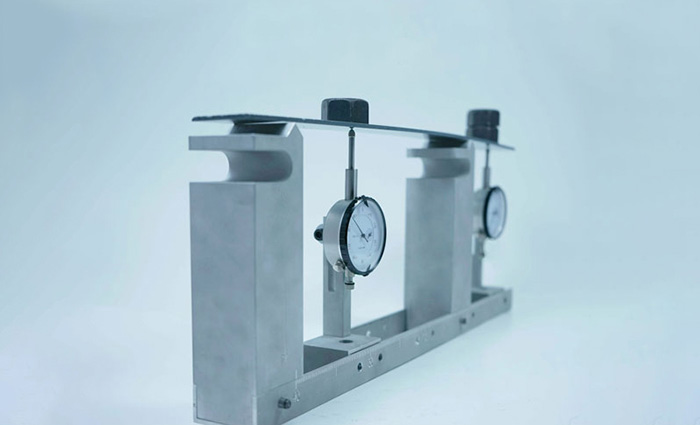Activity Overview
In this Activity, students build a series of point-loaded beams with various boundary conditions, and they observe the resulting deflections. Accompanying spreadsheets allows them to study how load, deflection, slope, moment and shear are related to each other.
This was our most expensive and technically challenging student model, and we use it in our first Mechanics of Deformable Solids (MODs) course, which we teach in year two of our program.
A spreadsheet accompanies the model, and if the boundary conditions and external loads on the beam are specified in the spreadsheet, it will calculate the resulting deflections. If, instead, the beam deflections are specified in the spreadsheet (presumably having been measured from the physical apparatus), the spreadsheet will calculate the loads required to produce those deflections (and these calculated loads should essentially match those actually acting on the physical apparatus).If the deflections are measured with sufficient care, the values calculated by the spreadsheet are often within 10 to 20% of the loads actually acting on the physical apparatus.

Learning Objectives
By the end of the activity, students should be able to:
- Read a dial gauge
- Discuss experimental errors associated with using dial gauges
- Explain the differences between simply-supported and clamped support conditions
- Demonstrate how various boundary conditions affect the deflected shape of a beam
- Show and explain how point loads a various locations affect the deflected shape of a beam
- Demonstrate emerging intuition about how beam deflect
- Demonstrate a rudimentary understanding of the relationship between beam load, deflection, slope, moment and shear.
And, if they made use of the spreadsheets,
Tips for Using the Activity
Students should be encouraged to enjoy the Activity.
They should not be rushed or under pressure to obtain the “correct answer” or a high grade.
Instead, they should be encouraged to think about how beams deflect and how the boundary conditions and loads influence beam deflection.
If students use the spreadsheets, they should be given considerable time to contemplate the relationships between deflection, slope, moment (curvature) and shear.
In any case, students might be asked to make supplementary observations or measurements. For example, they might place a short ruler tangent to the beam at various locations to measure slope or use the ruler to observe the degree and sense of the local curvature at various points.
Advanced students may be able to observe curvature changes along a cantilever beam that has a point load midway along its length, and they may be able to relate these changes to beam shear. Curvature changes (and shear) occur only along the portion of the beam between the support and the point load. No curvature changes or shear are present along the portion of the beam from the point load to its free end (except those due to beam self-weight).
Equipment Design
Many challenges were encountered in the design of this Activity, especially in measuring the deflection of points along the beam length. Dial gauges typically contain springs designed to keep their tips in firm contact with the objects whose positions they are measuring. Though negligibly small in most measurement settings, this contact force induced sufficient incremental deflections in our highly-flexible plastic beams that the readings were of little value. Removal of the springs in the gauges helped, but the plunger friction (even when graphite lubricant was used) was still sufficient that when resting on the beam from above, the gauge readings varied depending on whether the beam was pushing up on the gauge or not. Although the reading differences were only 5 to 10 thousandths of an inch, they were enough to make the spreadsheet results questionable. Our solution to this problem was to have students gently lift the gauges until they just touch the beam. With minimal practise, repeatability of 0.001” could be obtained. Non-contact gauges would have been ideal, but they exceeded our budget.
Additional Information
See the Downloadables section for more information on this activity.